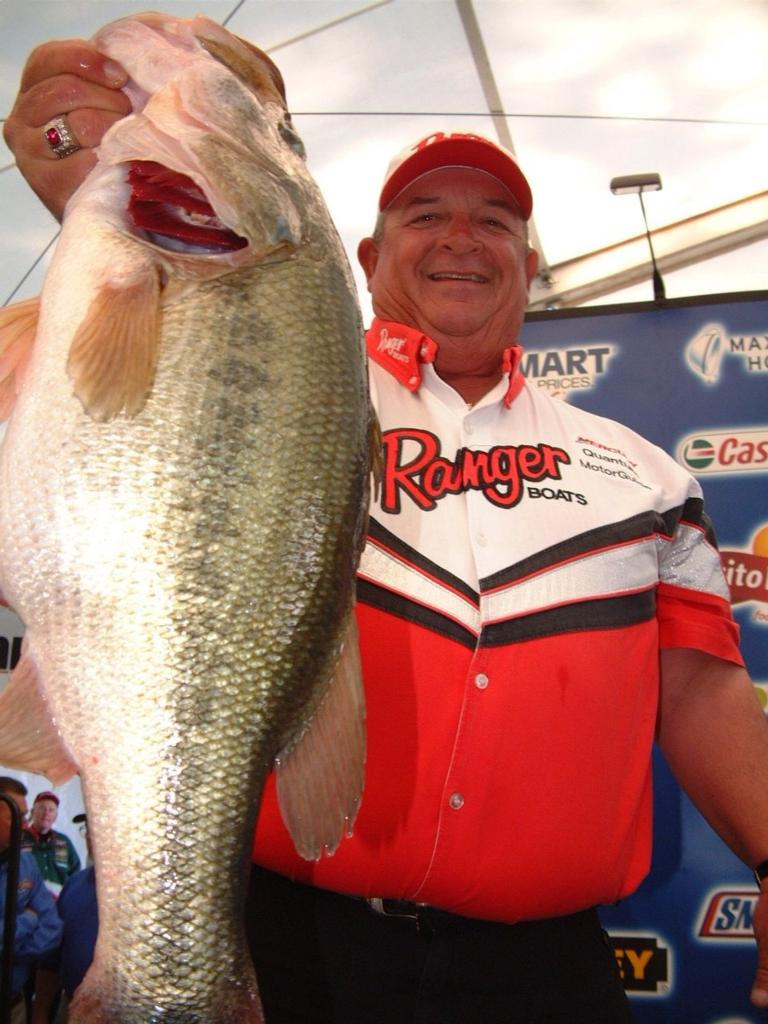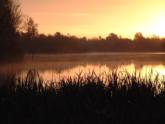Bass fishing’s civil war

Is American bass fishing better in the North than it is in the South? What about the West?
The North holds the FLW combined weight record, but you have to head below the Mason-Dixon Line to catch truly massive individual stringers. Continued from “Part one: The case for the North”.
Part two (of two parts): Not so fast, Yankee
While it might on the surface seem that the Yanks have better access to bass, a closer examination of the numbers and other extenuating factors reveal that the situation might not be all that bad in Dixie. The bass fishing in the South isn’t necessarily worse, just different from the North.
Champlain and St. Clair dominate the FLW record book’s top two spots in terms of total weight caught, sure, but the third heaviest tournament of all time happened at South Carolina’s Lake Murray in 2000. There, the Pro Division amassed 3,712 pounds, 15 ounces over four days. Then Kentucky Lake in 1998 ranks fourth with 3515-12 and Florida’s Lake Okeechobee in 2002 ranks fifth with 3,335-14.
In fact, only one more FLW tournament held in the North ranks in the top 10, and that happened at tour favorite Lake St. Clair, this time in 2001, which notched a sixth-best total of 3321-7. On the other end of the spectrum, one northern FLW tournament, the Connecticut River in 1998, was near the bottom of the list of 48 in 40th place with a weight total of just 878-14.
The best total for an FLW Championship, where there are just 50 pros or so competing, was at Mississippi’s Lake Ferguson in 1997 with a weight of 1,011-4. By comparison, the one northern championship, held on the Mississippi River in Moline, Ill., in 1998, only weighed in half that much with 527-2, which was a total even worse than the 2002 championship at Louisiana’s Cross Lake (559-11) where there was a prohibitive slot limit.
The South by no means has the monopoly on over-fished or low bass populations. Besides waterways like the Upper Mississippi and the Connecticut rivers, potentially low fish counts occur elsewhere in the North. For instance, the Ohio River, a frequent destination of the Wal-Mart BFL’s Buckeye Division, historically turns in low tournament weights. Ohio angler Gary Dees won the 2002 Buckeye Division tourney launched on the river out of Maysville, Ky., with a four-bass weight of just 7 pounds, and a mere 65 anglers out of 120 actually caught fish that day. (It can be argued whether the Ohio River is a “northern” waterway since it geographically delineates the Ohio-Kentucky and Indiana-Kentucky borders. But, for argument’s sake, the Buckeye Division is fished mainly by Ohioans and the Ohio River is the southernmost destination of that division’s tournament reach.)
 One of the biggest differences between northern and southern fishing is the size of the fish itself, and on that front the South has the decided advantage. Every bass angler knows that if you want to catch huge lunkers, you head south to places like Florida, Texas and, nowadays, California in search of those 10-pound, Florida-strain largemouths. In the North, where on a good day a tournament pro might nail 50 feisty smallmouths and cull out to a nice 20-pound limit, you just won’t see him land the likes of Dean Rojas’ tournament-record, five-bass stringer of 45 pounds, 2 ounces, which he caught at Florida’s Lake Toho in a B.A.S.S. event.
One of the biggest differences between northern and southern fishing is the size of the fish itself, and on that front the South has the decided advantage. Every bass angler knows that if you want to catch huge lunkers, you head south to places like Florida, Texas and, nowadays, California in search of those 10-pound, Florida-strain largemouths. In the North, where on a good day a tournament pro might nail 50 feisty smallmouths and cull out to a nice 20-pound limit, you just won’t see him land the likes of Dean Rojas’ tournament-record, five-bass stringer of 45 pounds, 2 ounces, which he caught at Florida’s Lake Toho in a B.A.S.S. event.
And it’s no secret that when you want to get serious about big-bass hunting, you head south of the border to places like Mexico’s Lake El Salto, where 10- to 12-pound largemouths are hardly worth a photo because they’re so numerous.
It’s no surprise, then, that the FLW Tour’s all-time heaviest one-day stringer was caught in the South. Jeff Coble caught 29 pounds, 6 ounces at Lake Santee Cooper in 1996 (one year after LMBV was discovered there). In fact, of the top 10 heaviest one-day stringers recorded by FLW pros, not a single one was caught in the North. Four of the top six stringers were caught at Santee Cooper and the other six in the top 10 were caught at either Kentucky Lake or Alabama’s Lake Eufaula.
What about the West?
Lost in the North vs. South argument is the angling in the American West, which in the world of big-time, televised professional bass fishing has long been overlooked. This is unfortunate because it could very well be that this country’s best bass fishing is in fact in the West.
Over the last few decades, fisheries officials in California have actively implemented Florida-strain largemouth stocking programs in lakes throughout the state. The predators have thrived in that state’s mild climate and deep, clear waters, and so has California’s bass-fishing industry.
The Golden State has come the closest to giving Georgian George Perry’s 70-year-old largemouth bass world record of 22 pounds, 4 ounces a run for its money when in 1991 a recreational angler hauled a state-record largemouth out of Lake Castaic that weighed 21-12. Since then, several largemouths in the 20-pound range have emerged from California waters.
Western tournament anglers have a good thing going, and they know it. California-native Aaron Martens, who has fished almost every conceivable type of water in the nation, is particularly fond of the big-bass, plentiful waters in his home state despite never having had the chance to win $100,000 in a big-money tournament there.
“(Lakes) Shasta and Oroville are incredible for the sheer number of fish in them,” he said. “You can go there in December and January and easily catch a quick 25 bass on jerkbaits. It takes a lot of weight to win a tournament there. Then there’s the California Delta and Clear Lake – Clear Lake is like a Play Station for bass fishing.”
“The California Delta is one of those huge places to fish,” Clark Wendlandt said. “It’s so big that it doesn’t feel the pressure as bad.”
 It’s not the region, it’s the lake
It’s not the region, it’s the lake
Most pro anglers who’ve been around the block on national bass-fishing circuits are quick to point out that it’s not really a matter of North vs. South or West vs. the rest, but more a matter of lake vs. lake.
“If you go individually from one body of water to another, you find that there are excellent fisheries everywhere,” Jim Moynagh said.
Many pros got hooked on Lake Champlain when the FLW Tour introduced it to their tournament repertoire in 2002, and the regional arguments presented here are mostly based on FLW Outdoors tournament results. But the sport of bass fishing does not exist exclusively on well-heeled, name-brand lakes famous for hosting tournaments. No matter what region you’re from – North, South, East or West – there’s a prime bass-fishing hole somewhere near you.
Consequently, every angler has his or her own personal favorites – and they’re all over the map.
Asked which American lake was his favorite, Moynagh points to one of the more remote splashes of blue on the map, and incidentally the northernmost point in the continental U.S.: “I don’t have one favorite lake, but what I like are places in the wild, a lake I can go to for seclusion as well as catching fish. I like northern Minnesota and southern Canada, places like Lake of the Woods. If you have a 200-boat tournament up there, you might only see two boats or so the whole day because it’s so big and doesn’t see a whole lot of bass fishermen. Plus, I like lakes with a mixed bag of largemouth and smallmouth bass.”
For Wendlandt, there’s no place like Champlain: “There is not a better place to fish anywhere. I’ve never seen a place like it. It’s just phenomenal. It’s unreal how much baitfish there is there. With the unlimited bait, that’s how the fish get so fat. It is my favorite lake by far.”
Martens, who agrees that Champlain (in the North) is probably the best but also loves his California (the West) hot spots, says some of his favorite lakes are in his adopted home state of Alabama (the South). (He recently bought a home there to ease his travels during tournament season.)
“Guntersville, Wheeler and Lay Lake are all fun lakes to fish,” he said. “They’re clean, a nice color, with lots of bass forage. They’re really healthy lakes and the average size of fish in all of them is huge. If you want to go somewhere and catch 40 fish a day, go to Lay Lake. That lake is incredible. In the fall or spring you can catch tons of 5- and 6-pound spot(ted bass). It’s the stupidest thing I’ve ever seen!”